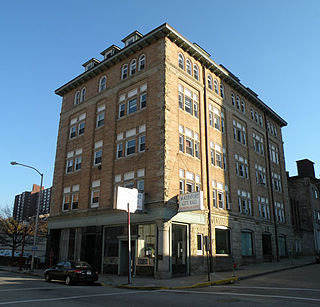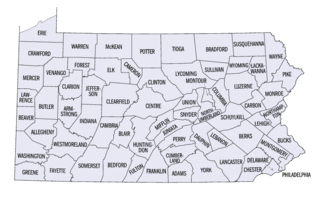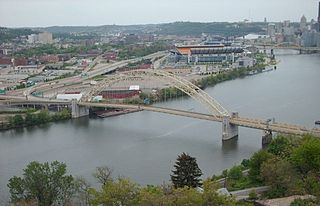
The National Road was the first major improved highway in the United States built by the federal government. Built between 1811 and 1837, the 620-mile (1,000 km) road connected the Potomac and Ohio Rivers and was a main transport path to the West for thousands of settlers. When improved in the 1830s, it became the second U.S. road surfaced with the macadam process pioneered by Scotsman John Loudon McAdam.

McKeesport is a city in Allegheny County, Pennsylvania, United States. It is situated at the confluence of the Monongahela and Youghiogheny rivers and within the Pittsburgh metropolitan area. The population was 17,727 as of the 2020 census.

Connellsville is a city in Fayette County, Pennsylvania, United States, 36 miles (58 km) southeast of Pittsburgh and 50 miles (80 km) away via the Youghiogheny River, a tributary of the Monongahela River. It is part of the Pittsburgh Metro Area. The population was 7,637 at the 2010 census, a decline from the figure of 9,146 tabulated in 2000.

Schenley Park is a large municipal park in Pittsburgh, Pennsylvania. It is located between the neighborhoods of Oakland, Greenfield, and Squirrel Hill. It is also listed on the National Register of Historic Places as a historic district. In 2011, the park was named one of "America's Coolest City Parks" by Travel + Leisure.

The Smithfield Street Bridge is a lenticular truss bridge crossing the Monongahela River in Pittsburgh, Pennsylvania, USA.

The Monongahela Incline is a funicular located near the Smithfield Street Bridge in Pittsburgh, Pennsylvania. Designed and built by Prussian-born engineer John Endres in 1870, it is the oldest continuously operating funicular in the United States.

This is a list of properties and districts listed on the National Register of Historic Places in Pennsylvania. As of 2015, there are over 3,000 listed sites in Pennsylvania. All 67 counties in Pennsylvania have listings on the National Register.

The Allegheny County Courthouse in downtown Pittsburgh, Pennsylvania, is part of a complex designed by H. H. Richardson. The buildings are considered among the finest examples of the Romanesque Revival style for which Richardson is well known.

The West End Bridge is a steel tied-arch bridge over the Ohio River in Pittsburgh, Pennsylvania, approximately 1 mile (1.6 km) below the confluence of the Allegheny and Monongahela Rivers. It connects the West End to the Chateau neighborhood on the North Side of Pittsburgh.

George Westinghouse Memorial Bridge in East Pittsburgh, Pennsylvania, carries U.S. Route 30, the Lincoln Highway, over the Turtle Creek Valley near to where it joins the Monongahela River Valley east of Pittsburgh. The reinforced concrete open-spandrel deck arch bridge has a total length of 1,598 feet (487 m) comprising five spans. The longest, central span is 460 feet (140 m), with the deck height 240 feet (73 m) above the valley floor, for a time the world's longest concrete arch span structure. It cost $1.75 million. The design engineers were Vernon R. Covell and George S. Richardson, with architectural design by Stanley Roush. The pylons at the ends of the bridges feature Art Deco reliefs by Frank Vittor.

The David McCullough Bridge, commonly and historically known as the 16th Street Bridge, is a steel trussed through arch bridge that spans the Allegheny River in Pittsburgh, Pennsylvania.

The Mexican War Streets, originally known as the "Buena Vista Tract," is an historic district that is located in the Central Northside neighborhood of Pittsburgh, Pennsylvania, in the United States. The district is densely filled with restored row houses, community gardens, and tree-lined streets and alleyways. The area dates to around the time of the Mexican–American War.

The Armstrong Tunnel in Pittsburgh, Pennsylvania, connects Second Avenue at the South Tenth Street Bridge, under the Bluff where Duquesne University is located, to Forbes Avenue between Boyd Street and Chatham Square.

The Schenley Farms Historic District, also referred to as the Schenley Farms–Oakland Civic District, is a historic district listed on the National Register of Historic Places that is located in the Oakland section of Pittsburgh, Pennsylvania, United States.

The Hawthorne School was a historic, Tudor Revival school building in Canonsburg, Pennsylvania. It was listed on the National Register of Historic Places on May 8, 1986.

The Carnegie Free Library of Allegheny is situated in the Allegheny Center neighborhood of Pittsburgh, Pennsylvania. It was commissioned in 1886, the first Carnegie library to be commissioned in the United States. Donated to the public by entrepreneur Andrew Carnegie, it was built from 1886 to 1890 on a design by John L. Smithmeyer and Paul J. Pelz.

Connellsville Union Passenger Depot, also known as the Connellsville Pittsburgh & Lake Erie Station, is a historic railway station located at Connellsville, Fayette County, Pennsylvania. It was built between 1911 and 1912 by the Pittsburgh and Lake Erie Railroad and Western Maryland Railway. It is a 1 1/2-story, rectangular brick building measuring 109 feet by 28 feet. It features a three-story tower, wide overhanging eaves, and hipped roofs on the building and tower covered in blue-green Spanish terra cotta tiles. It is in an American Craftsman style of architecture. It ceased use as a passenger station in 1939, after which it housed a car dealership and auto parts store. It was purchased by the Youghiogheny Opalescent Glass Company in the spring of 1995.

Joseph Franklin Kuntz was an American architect who was based in Pittsburgh, Pennsylvania. He designed at least eighteen armories in Western Pennsylvania, with the W.G. Wilkins Company, following the 1905 creation of a state armory board.
Vernon R. Covell was an American engineer. He was chief engineer of the Allegheny County Public Works Department.

George Sherwood Richardson (1896–1988) was an American engineer known for his elegant bridges, innovative construction techniques and skillful planning of highways. Designer of many bridges in the Pittsburgh and Allegheny County areas in the 20th century, he has been called "the dean of Pittsburgh bridge engineers".
























